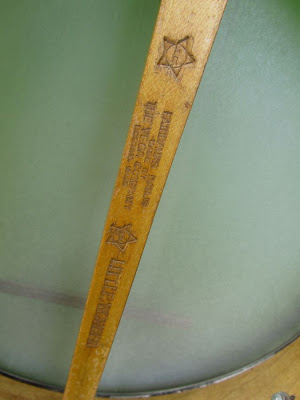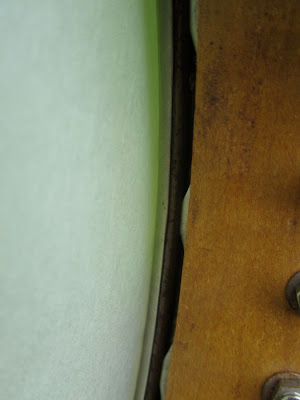c.1920 Vega "Little Wonder" (Whyte Laydie Ring) 6-String Banjo Guitar
Rare, rare, rare! It's extremely hard to find 1920s-30s banjo-guitars (banjo rim with guitar neck), but even harder to find really good quality ones. This is the same instrument as this one, but now it's all fixed!
Vegas (out of Boston) are known for their high quality builds, but their banjo-guitars are also known as essentially the best available on the vintage market. They're regularly seen in jazz-era photos of bigger bands where the banjo-guitar is either playing nice thick backing chords or ripping out biting leads.
This instrument was built in 1920 per its serial number and was sold as a "Little Wonder" which it fits out "to spec" except that the tonering was an upgrade from the factory. Usually a "Little Wonder" ring is a hoop fit into a spunover plated-brass sleeve that then sits on the top. This instrument has the (even more desirable) "Whyte Laydie" tonering, which is essentially the same thing but with the addition of a 2nd "toothed" ring that the whole sleeve & hoop ring sits on. If you check out the link above to the repair process it's easy to see this design.
The "Whyte Laydie" ring is widely considered one of the best "old time" banjo tonerings, and it's easy to see why -- crisp but warm tone with a sweet voice and overtones that are pretty but not overpowering to the fundamentals.
The rim hardware is all-original, save one hook & nut, the new Remo Renaissance head, new rosewood (compensated) bridge, and a mid-20s armrest I had in my parts bin. I'd been waiting around to use it on something that would be worthwhile, and this thing certainly is that!
This banjo's neck required a lot of work. Again, if you check out this link you can see the repair process. I reglued a bunch of cracks, hairline and otherwise, and gave it a fret level/dress. Someone had previously installed 1960s-era Kluson 3-to-a-plate guitar tuners in favor of the original friction pegs, as well, and also drilled a "strap hole" at the top of the headstock. I was originally going to install some replacement friction pegs like the original Vega specs would have had, but thought better of it and installed some individual Kluson-style replacements instead. I figured guitar players (who have a devil of a time with banjo pegs) would thank me later, and considering the "paddle" style headstock, the right-angle gears look natural, anyway.
Woods: the veneer on the headstock is dyed something or other. The nut is bone and original.
Fretboard is ebony and I believe the frets are original, though I'm not sure -- the ends have been dressed in the past so I'd need to take them out to tell 100%. Pearl dots.
The neck is also super comfortable. The nut nears 1 7/8" wide but front to back the neck is slimmer than most vintage guitars and has a cozy light D shape to it. Think vintage Martin but with a D rather than V shape.
I used a mandolin-style bridge in rosewood because #1 it provided a wider surface to compensate the break of the strings and #2 is much more stable than a regular banjo-style bridge on a 6-string configuration, which means better tuning stability and no warping over time. The added mass also cuts down on the ridiculous amount of random overtones guitar-banjos tend to produce and are exacerbated on the larger-than-normal 11 13/16" rim.
This bridge is compensated for what I consider ideal banjo-guitar strings: light gauge electric strings (10s). The unwound G of nickel-wound electric strings and the overall lighter set make this sound way more "banjo" than a typical "light" guitar set at 54w to 12, which would overdrive the head and give an ugly, compressed, flabby sound.
It's a gorgeous instrument with reserved but classy ornamentation. 5-ply maple rim, 2-piece with center strip maple neck, ebony board, dyed heel cap and headstock, and of course that wonderful tortoise binding at the bottom edge of the rim.
The new Kluson tuners work great, but for a purely vintage look StewMac offers a number of repro 1920s and 1930s 3-on-a-plate tuners that would look even better, but they are relatively pricey depending on the set you get.
Another optical illusion here -- the action looks high but it's actually super slinky at a little over 1/16" at the 12th fret on the bass side.
I love the natural finish on Vega "Little Wonder" spec instruments. The heavy-duty quality Vega hardware doesn't hurt, either!
The tension hoop is grooved so the hooks grab it nicely and don't protrude over the top edge.
Here you can see the long hairline crack that runs from the heel to the headstock. It's very thin up at the headstock area, but grew to a little over 1/8" deep at the heel. It's all clamped up and "stable in service," though. In addition to this one I reglued a hairline at the headstock itself and a center-seam separation of the headstock as well. Like this crack, all is well, now.
Nice polish finish on this instrument. Vegas often "feel" like Martins in terms of fit and finish. Very classy and simple.
Here you can see some of the funkiness done previously at the headstock. The "hole" in the center was probably for a strap hanger or hanging it on a wall. The extra holes around it were attached to a mending plate that did an OK (but not ideal) job of holding the headstock together.
Nice dowel cap, here.
"Fairbanks Banjo, made by Vega," yadda yadda and the "Little Wonder" mark.
But here's what's under the hood for real -- a Whyte Laydie tonering!
Matching serials and nice original neck brace all accounted for.
Original 6-hub "No Knot" style tailpiece. The black foam is just held on by pressure and mutes the "extra string length" to remove excess overtones. It's unnecessary but I like to damp my extra strings, personally, to clear up fundamentals. It's a mandolin habit!
I added this 1920s-ish arm rest because I thought it'd look the part, and it does. Also makes strumming and picking this a bit more comfy.
Original leather case, not in the best of shape, but good as a dust cover and (if the strap for the bottom drop is repaired) could be a good usable item.

























Comments